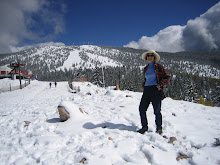South to Durango

Monday
March 5
As we head further south into tierra adentro, it seems that our departures are becoming earlier. We board the bus by 7:45 a.m. and leave for Durango. We pass through the town of “Matamoris” (literally “kill the Moors”), then enter an area of rolling hills. To our west loom the distant Sierra Madre mountain range. Standing at the front of the bus like the professor he is, Hal takes the microphone and delivers background information for what we’ll be seeing today. In 1776, he tells us, Pedro Rivera described Parral as a city in which citizens are “Espanoles, mestizos and mulatos.” Religious orders -- Franciscan, Augustinians and Jesuits -- competed for the souls of these citizens.
We pause briefly at the mining town of San Miguel de Ocampo. Hal continues his discourse, stressing the importance of support for the mining activity. It took twenty people, including farmers, cooks, and blacksmiths, for each one miner. Many of the Indian workers were migrants, traveling from one job to the next. Much of the commerce along El Camino Real was generated by mining and accompanying enterprises.
This is indeed “Pancho Villa territory.” The bus pulls up to the Pancho Villa Museum, where we disembark and spend a couple hours perusing a fascinating collection of photos and artifacts. The former reveal a Pancho Villa who was loved and respected, not just the outlaw I’ve always imagined. My favorite shots include: a 1921 picture of Villa garbed entirely in white; a 1971 photo of Villa with wife Dona Luz and their son Jose Miguel Salcido Romero, a dinner table shot of Villa with Zapata and another politico named Gutierrez. One wall boasts grim photographs of Villa’s cadaver.
One room is devoted to Fiero, Villa’s thuggish second-in-command. He looks like a monster in his scowling photographs. Hal’s story about Fiero confirms my impression. While under Villa’s command, Fiero told 150 imprisoned men that they could earn their freedom if they could run across the plaza and climb a high wall. He let the prisoners out of their cells and as they ran across the plaza toward the wall, he shot them. Of the 150, only two lived. It was no surprise, therefore, that when when Fiero was drowning in a marsh, no one would answer his cries for help -- even though he was surrounded by his own men. They stood around watching him die.
Back in our “motor coach,” we travel east to Cerro Gordo, site of an early presidio. , As were most of Mexico’s 16th and 17th century presidios, it was established because of its proximity to water. In the 1820s, Cerro Gordo was ravaged by Comanches. We get out and stroll. Inez, Luis and I go to the local post office to buy stamps for post cards to America. This is apparently quite an odd request, and the post mistress can only give us enough stamps for four cards, several denominations having to be pieced together.
That done, we went to the Cerro Gordo church. It is hot outside and the church’s cool interior, its alcoves adorned with statues of saints, provides welcome relief. Outside the church, as we head back toward our to our vehicle, we meet a sad Mexican cowboy who’d been living in Kansas with his wife and three children. He’s divorced, he tells us, and had to come to Mexico to find work. He misses his kids, worries about them, and hopes he’ll see them again someday.
We’re headed south, getting close to the Tropic of Cancer. Luis expounds on the Mayan calendar and tells us about a cult for the historic “Revolt of the Warriors.” There are many Mexican customs related to the calendar, he says, and every spring there is a vast, celebratory camping out of those who honor the warrior cult.
We draw near the mines of Casco, a place where Onate stayed for nine months. Next to the road is a cienega that, according to Hal, Onate surely passed in his travels on El Camino Real. Suddenly we are in the mountains. Giant cacti are blooming on either side of the bus. The Nazas River heralds a fertile stretch of greening trees, verdant fields and bushes of yellow blossoming flowers.
Because of so many miles to cover, lunch is overlooked today. We make do with Hal’s daily provisions, granola bars and small cans of fruit juice. Progress is steady but slow. It does not help that we get behind a funeral procession just south of the Nazas River. At 5:30 p.m. the sun is down and a gorgeous sunset begins to fill the sky. We travel deep valleys, wind around curves on a narrow road, catching glimpses of city lights. Like a mirage, they appear and disappear. It is very late when finally reach Durango and check into Hotel Casablanca.







0 Comments:
Post a Comment
<< Home